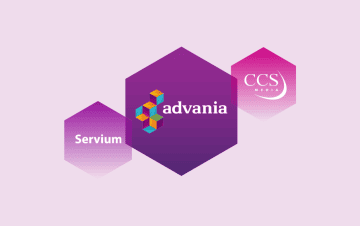We’re fresh back from trips to Las Vegas, where we attended the ever-insightful HPE Discover event and Dell Technologies World. As always, these events presented great opportunities to network and learn more about what some of the world’s biggest technology vendors are planning, but it’s also given us a welcomed injection of perspective, serving up interesting things to think about from AI, to cloud, to the continued evolution of as-a-service solutions like HPE GreenLake and Dell Apex.
As we move into the latter half of the year, it’s crucial to keep an eye on the horizon and plan for what’s coming down the line – especially in a field that evolves as rapidly as IT.
An end to the cloud hype cycle?
One of the key takeaways from HPE Discover was the idea of cloud rebalancing. The concept is simple – businesses need to find their optimal balance between on-prem and cloud infrastructure, which means you need mobility both ways: migrating more into the cloud, and pulling back to on-prem when necessary. In a sense, it’s like a pendulum – businesses need to find equilibrium between their on-premises and cloud deployments, and settle on a comfortable balance. Interestingly, the movement of workloads back to on-premises environments is becoming more commonplace as part of this rebalancing.
This speaks to the fact the cloud’s come a long way as a technology, but also as these rebalancing trends take hold, maybe suggests we’re perhaps at the end of its hype cycle and we’re settling down into a new normal. That’s not to say the cloud is no longer useful or innovative, but rather that businesses are no longer treating it as the silver bullet solution for all their problems.
But with one hype cycle ending, another begins – the buzz around artificial intelligence. AI has been on the IT horizon for years, maybe even decades, but it’s only recently evolved into something businesses can genuinely harness and see the benefit of with the arrival of ChatGPT. The potential here is clear, and it seems like every business is finding a way to connect themselves to AI in one way or another – whether that’s using it to generate content, assist in writing code, or as a research tool.
In a sense, we’re no different – we’re working to onboard four AI companies into our Services Ecosystem, but with a tighter focus. We believe our customers will see the most benefit from AI when it’s used to enhance their IT operations through data visualisation, automation, and analysis, and that’s where our interest lies.
As-a-service is here to stay
While the cloud hype cycle may be at its end, one of the key concepts behind it continues apace: as-a-service models for infrastructure, especially on-premises. Services like Dell Apex and HPE GreenLake are nothing new, but they’ve really come into their own as well-articulated, mature business models that can really help businesses excel.
The promise these kinds of services offers is one that businesses need to pay attention to – enabling a cloud-like experience for on-premises environments. We call it “cloudifying your datacentre” – if you want to know more about how that works, check out our recent guide on the subject as it relates to HPE GreenLake, and how it helps businesses drive their IT operations forwards.
As more and more organisations start to pay attention to and adopt these services, they’re continually developing to meet new requirements – such as enabling co-location agreements for businesses which don’t own their own datacentre or want to move away from doing so, as well as other changes to make them more suitable for use by smaller businesses.
If you’re planning a move to one of these services, it’s critical to ensure that it’s well considered: issues like scaling during peak workload periods, or understanding what off-ramps exist to exit the service are critical, and having a fully formed strategy before making any moves can go a long way. Still, their increasing capabilities and maturity confirms that they’re developing as a real alternative to cloud infrastructures. Indeed, our own customer engagements reflect businesses wanting to explore these services, particularly as they face data centre refresh or look at new ways to create operational efficiencies.
Dodging ransomware
Of course, no CEO edit would be complete if we didn’t touch upon security. Attacks are always on the rise, and new trends are always developing – for example, the growing market for Ransomware-as-a-Service saw the number of these attacks increase by 40% in the last year alone.
Ransomware-as-a-Service, as well as other trends like using generative AI to create more convincing phishing materials, serve only to lower the bar for bad actors to launch attacks – and it’s a great time for them to do so.
As cloud rebalancing takes off, businesses can find themselves overlooking gaps in their security – especially in the case of SaaS data, which is usually held in a public cloud separated from the business, but it’s still the business’s responsibility to secure it.
When it comes to fending off ransomware, having safe backups are essential, giving businesses the ability to recover their data without paying a ransom (after kicking the attackers out of the system, of course). To this end, we’re proud to be one of the leading UK partners for Arcserve – an award-winning vendor that offers a brilliant portfolio of backup and data recovery solutions.
Arcserve has a wide portfolio of solutions (take a look at our explainer if you want to know more) but of particular note is their SaaS Backup, which takes data generated by SaaS apps in the cloud and secures immutable copies of it in UK datacentres to ensure it’s safe from cybercriminals, which provides a useful safety net, especially for businesses in the midst of cloud rebalancing.
Expanding our reach
Lastly, it’s important to touch on Servium’s own growth. So much of what we do is focused on how well we service our customers, and a key part of that is being able to deliver new technology quickly and effortlessly across the UK and beyond.
Challenges stemming from Brexit have made this difficult in Europe – not just for us, but for many businesses. Fortunately, we have a solution. We’re expanding our reach in Europe, enhancing our shipping processes and capabilities across the continent to speed up our service for all of our customers.
At the heart of this lies our plans to open Servium GmbH – a new branch of the company headquartered in Germany to help us optimise logistics and commercial transactions throughout Europe as well as enhancing our ability to support our customers.
We’ll have more news on this to follow, so be sure to keep up with us on LinkedIn and Twitter for updates.
That’s all from me for this quarters CEO Edit. If you have any questions about any of the topics I’ve covered, or want to reach out to us to discuss your IT plans, speak to your Servium Account Manager or get in touch with the team.
You may also be interested in
A new name for CCS Media & Servium is coming
This summer, Advania UK companies CCS Media and Servium will change their names to better reflect the unified business. Together, we will all be known as Advania.
End of an “EA-ra” but Microsoft CSP opportunities await
We take a deep dive into Microsoft’s curtain call on Enterprise Agreements and the move to CSP. Find out how an expert, partner-led approach from Servium and Advania can help your business optimise spend, drive innovation, and fully leverage Microsoft Cloud.
Why employee intranets are more essential than ever
Intranets are still a vital tool for your business, but today's digital workplace demands more than just a standard SharePoint site. Discover how Fresh Intranet combines the control of traditional systems with cutting-edge Microsoft 365 integration and AI capabilities, creating a truly unified digital experience that works for everyone.
 Paul Barlow
Paul Barlow





